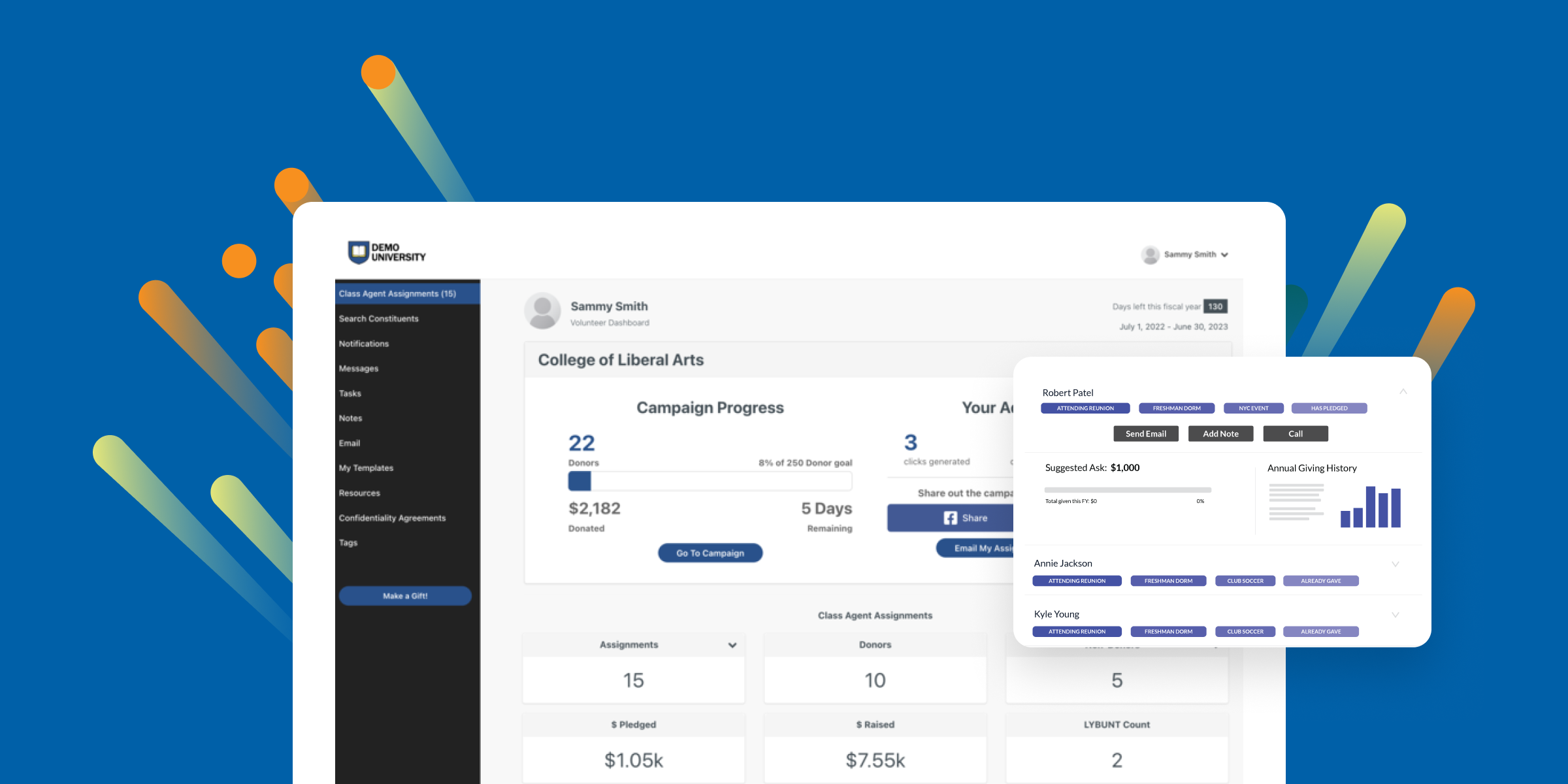Parents of K-12 students are more likely to take a hands-on role in their child’s education than parents of higher ed students—and that’s good news if you’re a K-12 fundraiser. You can lean into this tendency for parents to be more actively involved to build deeper connections with them. Because parents may be more intimately vested in educational outcomes, they can be influential when it comes time to raise money for key initiatives at your school.
Parent volunteers and donations can ultimately be the cornerstone of a successful fundraising initiative. The Calvert School—a K-8 private school in Baltimore—has seen consistently high rates of parent donor participation, largely driven by their 75 parent volunteers.
Below you’ll learn how to recruit parent volunteers to support your fundraising efforts and ultimately to donate to your organization.
Parent Volunteer Recruitment
Whether you’re maintaining an already flourishing parent volunteer program or starting a volunteer initiative from scratch, recruitment is an essential piece of the puzzle. You may be thinking “How do I ask my parents to volunteer?”
Timing is key when it comes to recruiting potential parent volunteers.
You’ll likely want to kick off your recruitment efforts before the school year even begins. Lauren Murphy—the Director of the Calvert Fund at Calvert School—starts her parent volunteer recruitment during the previous school year.
“We find people are happy in the spring—the end is near— and they’re more likely to say yes. We recruit all of our volunteers for the next fiscal year in the spring,” Murphy said.
When positioning your parent volunteer program, it’s important to think about the various levels of participation you might offer to different audiences. You may choose to segment your communications with parents so you invite them to volunteer at a time and commitment level that is most likely to match their situation. For example, new parents to the school or working parents might be presented with lower commitment opportunities than active volunteers from the current fiscal year.
Not every school will have 75 parent volunteers spread through six different committees like Calvert School. However, you will want to consider recruiting parents that serve different segments of the school. Get at least one to two parents from each grade level so you have representation for all the classes.
You should also consider recruiting and assigning parent volunteers who have ties to key affinity groups like athletics programs or the arts. These parents may have peer networks that can help you expand your reach. Likewise, parents who are also alumni of your institution will know other alumni and be better equipped to solicit and engage this coveted cohort in more personal and meaningful ways.
How to Use Parent Volunteers to Maximize their Impact
Once you’ve concluded the recruitment process, you’ll want to strategize how to assign activities that are easy for your parent volunteers to execute—and make the best use of their time and talents. Parent volunteers can assist in numerous ways and having extra hands on deck can be the determining factor in the success of your programs and initiatives.
What are some appropriate activities for parent volunteers?
Peer-to-peer fundraising is one key way to use your parent volunteer program. Especially if you have parent-targeted fundraising campaigns, getting parent volunteers to assist in gift solicitation can be powerful.
It’s important to make it as easy as possible for your volunteers to help ask for donations. At Calvert School, they give parents sample messaging they can use to meaningfully engage their peers.
“We give them every script they could possibly need to copy and paste for a text message, email, or phone call. And, we’re in frequent communication to celebrate their successes,” Murphy said.

Parent volunteers can play a vital role in your fundraising events too. Whether it’s helping plan and market an annual gala or staffing the booths at a fundraising auction, parent volunteers can be instrumental in pulling off a successful event—especially if your budget is limited.
Regardless of the tasks you choose to assign your parent volunteers, keeping everyone organized and accountable will be key. Using a volunteer management system can help streamline your volunteer processes and keep resources all in one place. As mentioned above, making the volunteer experience as easy and frictionless as possible will increase the likelihood that parents will stay involved and execute tasks in a timely manner.


Increasing Parent Participation
Parent participation is one of the most important metrics to look to when it comes to both parent volunteers and parent donations. As all fundraisers know, engagement can be just as important as dollars raised. Having a parent participation goal is key when you begin developing a parent-focused campaign.
For Calvert School, their annual parent donor participation benchmark is an impressive 90 percent.
“We never want to fall below. We always want to exceed ninety,” Murphy said. “We know in the room that’s not an easy task. But it’s certainly motivating and ultimately very rewarding when the fiscal year ends for us in June.”
Your school may have a lower benchmark for parent participation, but you should look at it just the same—as a number against which you can measure your progress throughout the year. One strategy is to base a campaign around benchmark progress.
Knowing they previously were able to hit 54 percent by the 1st of November, Calvert launched a parent campaign branded “Calvert Fund: 60 x 60.” Their goal was to achieve 60 percent parent participation in the first 60 days of the school year.

Showcasing your participation goal helps create a sense of camaraderie and can help drive engagement. Additionally, focusing on participation—rather than dollars raised—helps increase accessibility so parents of all means can get involved. A participatory gift of ten dollars is just as impactful for reaching the participation goal as a major gift in the thousands.
How to Effectively Solicit Parent Donations
Parents comprise a key donor segment in the K-12 world and your parent volunteer program can help you better solicit this cohort.
Just like it’s important to segment parents when recruiting volunteers, it is also important to do so when soliciting parent donations. The Calvert School equips their parent volunteers with a tailored communication strategy for engaging prospective parent donors.
“We certainly are careful about our targeting. Every single parent gets a target ask that sticks with them throughout the year and in their messaging,” said Murphy.
In addition to tailoring the ask amount in your messaging, you should think about other ways to segment your parents. For example, if your school has day students and boarders, you might have different fundraising events or initiatives for the parents of each of these segments.
The Hun School—a 6-12 boarding and day school in Princeton, New Jersey—developed a guide to giving and getting involved for parents as part of the initial launch of their parent program. It included information about various designations within the Hun Fund along with other avenues to give back, like volunteer opportunities. This resource was sent out as a physical mailer—rather than just electronically—allowing them to further segment their messaging in accompanying cover letters.
“If you were a returning family, your message was very different than if you were a new family,” said Jennifer Harris, Director of Parent Giving and Engagement at the Hun School. “We talked to parents about the tuition gap. The school invests $5300 per student—every single student at Hun—regardless of whether you are full pay or have financial aid.”


Education is also a crucial component of effectively soliciting parents. Not all parents are familiar with how funds are distributed at an institution or the impact dollars towards a particular designation have.
If you have a robust parent volunteer program, you may have a volunteer representative from your different parent donor segments. They can help provide insight into what kind of messaging may resonate with different groups.
Peer-to-peer asks are a great way to personalize communication with prospects regardless of their segment. Having a fellow parent solicit can feel less intrusive and ultimately help get donors over the finish line.
Summary
Involving parent volunteers in fundraising efforts brings numerous advantages, from more personalized outreach to increased participation rates. With strategic recruitment and organized engagement processes, parent involvement can lay the foundation for successful fundraising initiatives at K-12 schools.
A solution like GC Volunteer Management, one of the most widely used platforms in educational fundraising, can help you organize your parent volunteer programs and deliver the kind of rewarding and impactful experiences that ensure parent supporters will keep raising their hands when asked.
To learn more about how GiveCampus can help you scale your parent volunteer program and gain more donors, speak with a fundraising pro.




